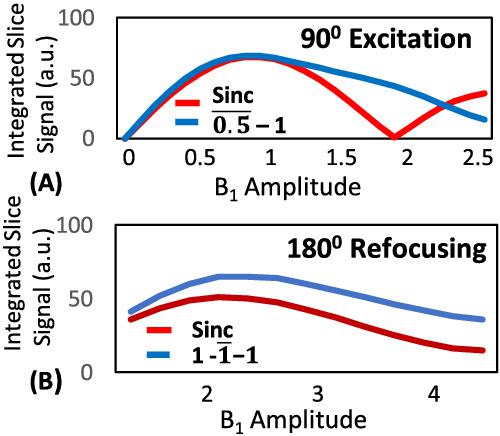当前位置:
X-MOL 学术
›
NMR Biomed.
›
论文详情
Our official English website, www.x-mol.net, welcomes your
feedback! (Note: you will need to create a separate account there.)
Ultra‐high‐field MRI using composite RF (STEP) pulses
NMR in Biomedicine ( IF 2.7 ) Pub Date : 2020-11-17 , DOI: 10.1002/nbm.4445 Roger Ordidge 1 , Jon Cleary 1 , Rebecca Glarin 1 , Yasmin Blunck 1 , Shawna Farquharson 2 , Bradford Moffat 1
NMR in Biomedicine ( IF 2.7 ) Pub Date : 2020-11-17 , DOI: 10.1002/nbm.4445 Roger Ordidge 1 , Jon Cleary 1 , Rebecca Glarin 1 , Yasmin Blunck 1 , Shawna Farquharson 2 , Bradford Moffat 1
Affiliation

|
Ultra‐high field MRI offers many opportunities to expand the applications of MRI. In order for this to be realized, the technical problems associated with MRI at field strengths of 7 T and greater need to be solved or mitigated. This paper explores the use of new variations of composite RF pulses, named serial transmit excitation pulses (STEP), in contrast to parallel pulse techniques, in order to remove and/or mitigate the effects of non‐uniform B1 excitation fields associated with the subject (eg the human brain). Several techniques based on STEP sequences are introduced and their application to human brain imaging is presented and evaluated.
中文翻译:

使用复合射频 (STEP) 脉冲的超高场 MRI
超高场 MRI 为扩大 MRI 的应用提供了许多机会。为了实现这一点,需要解决或减轻与场强为 7 T 或更高的 MRI 相关的技术问题。本文探讨了复合射频脉冲的新变体的使用,称为串行发射激励脉冲 (STEP),与并行脉冲技术相比,以消除和/或减轻与非均匀B 1激励场相关的影响主题(例如人脑)。介绍了几种基于 STEP 序列的技术,并介绍和评估了它们在人脑成像中的应用。
更新日期:2021-01-04
中文翻译:

使用复合射频 (STEP) 脉冲的超高场 MRI
超高场 MRI 为扩大 MRI 的应用提供了许多机会。为了实现这一点,需要解决或减轻与场强为 7 T 或更高的 MRI 相关的技术问题。本文探讨了复合射频脉冲的新变体的使用,称为串行发射激励脉冲 (STEP),与并行脉冲技术相比,以消除和/或减轻与非均匀B 1激励场相关的影响主题(例如人脑)。介绍了几种基于 STEP 序列的技术,并介绍和评估了它们在人脑成像中的应用。











































 京公网安备 11010802027423号
京公网安备 11010802027423号